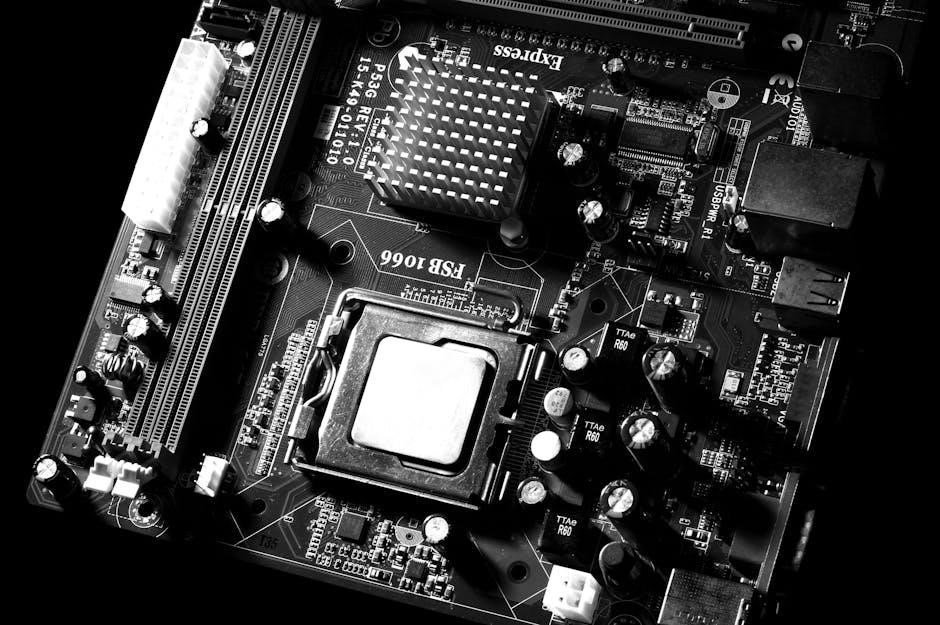Electrical engineering, emerging in the late 19th century, has evolved from focusing on power and telegraphy to encompassing renewable energy, smart grids, and robotics. It is an interdisciplinary field, integrating power, information, and technology to design and innovate systems that shape modern life.
1.1. Definition and Scope
Electrical engineering is a dynamic and versatile field that focuses on the design, development, and maintenance of electrical systems, devices, and technologies. It encompasses a broad range of applications, from power generation and distribution to communication systems and electronic devices. The scope of electrical engineering has expanded significantly over time, evolving from its origins in telegraphy and telephony to include modern disciplines such as renewable energy, smart grids, robotics, and automation. Electrical engineers work on creating innovative solutions to meet the growing demand for efficient and sustainable technologies. The field is deeply intertwined with other engineering disciplines, making it an interdisciplinary area of study. Electrical engineering plays a critical role in addressing global challenges, such as energy sustainability and advanced communication systems, while also driving technological advancements in industries like healthcare, transportation, and manufacturing. Its applications are vast, impacting nearly every aspect of modern life.

1.2. Historical Development
Electrical engineering traces its origins to the late nineteenth century, emerging from the study of electrical circuits, telegraphy, and telephony. Over time, the field has expanded significantly, adapting to technological advancements. In the early 20th century, the focus shifted to power generation and distribution, laying the foundation for modern electrical systems. The mid-20th century saw the integration of electronics and computing, revolutionizing communication and control systems. Today, electrical engineering encompasses a wide range of disciplines, including renewable energy, smart grids, and robotics. The historical development of the field reflects its ability to evolve and address global challenges, from energy sustainability to advanced communication technologies. This dynamic progression has positioned electrical engineering as a cornerstone of modern technological advancements, shaping industries and improving quality of life worldwide.
1.3. Core Disciplines
Electrical engineering encompasses several core disciplines that form the foundation of the field. These include electrical circuits, electromagnetism, power systems, electronics, control systems, telecommunications, and microelectronics. Electrical circuits focus on the analysis and design of networks containing components like resistors, capacitors, and inductors. Electromagnetism deals with the interaction between electric and magnetic fields, essential for understanding wave propagation and antennas. Power systems involve the generation, transmission, and distribution of electrical energy, ensuring reliable power supply. Electronics explores the behavior and application of active components such as diodes and transistors, while control systems emphasize feedback mechanisms to regulate dynamic systems. Telecommunications covers data transmission through wires, fiber optics, and wireless media. Microelectronics focuses on the design and fabrication of integrated circuits and semiconductor devices. These disciplines collectively provide the theoretical and practical framework for electrical engineering, enabling advancements in technology and solving real-world problems.

Fundamental Principles

Electrical engineering is rooted in fundamental principles such as charge, current, voltage, resistance, Ohm’s Law, Kirchhoff’s Laws, energy, and power. These concepts form the foundation for analyzing and designing electrical systems.
2.1. Electrical Circuits
Electrical circuits are the backbone of electrical engineering, representing pathways through which electric current flows. A circuit consists of components like resistors, capacitors, inductors, and power sources connected by conductors. These components interact based on fundamental laws such as Ohm’s Law, Kirchhoff’s Voltage and Current Laws, and Thevenin’s Theorem. Circuits can be classified into direct current (DC) or alternating current (AC) systems, each with unique characteristics and applications. DC circuits, like those in batteries, provide steady current, while AC circuits, used in power distribution, offer efficient voltage transformation. Circuit analysis involves calculating voltage, current, and power across components, essential for designing systems from simple lighting to complex electronic devices. Understanding circuit behavior is critical for ensuring safety, efficiency, and functionality in electrical systems. Advances in circuit design have enabled innovations in electronics, telecommunications, and renewable energy technologies.
2.2. Electromagnetism
Electromagnetism is a fundamental concept in electrical engineering, describing the interaction between electric and magnetic fields. It is governed by Maxwell’s equations, which unify the previously separate theories of electricity and magnetism. Key principles include the electric field, magnetic field, and their interdependence. Electromagnetic induction, discovered by Michael Faraday, explains how a changing magnetic field generates an electric field, forming the basis for transformers and generators. Electromagnetic waves, such as radio waves, microwaves, and light, are propagated due to oscillating electric and magnetic fields. These waves are crucial for communication systems, radar, and wireless technologies. Understanding electromagnetism is essential for designing antennas, motors, and high-frequency circuits. It also underpins technologies like MRI machines and wireless charging. The study of electromagnetism bridges theory and practical applications, enabling innovations in telecommunications, power systems, and medical devices.
2.3; Power Systems
Power systems are critical infrastructures that enable the generation, transmission, distribution, and consumption of electrical energy. They form the backbone of modern society, powering everything from households to industries. The core components of power systems include power plants, transmission lines, transformers, and distribution networks. Electrical engineers design these systems to ensure reliability, efficiency, and safety. Key considerations include voltage regulation, power quality, and fault protection to maintain consistent energy supply. The integration of renewable energy sources, such as solar, wind, and hydroelectric power, is transforming traditional power systems into smarter, more sustainable grids. Advances in power electronics and smart grid technologies are improving energy management and reducing losses. Power systems also require careful planning to meet growing demand while addressing environmental and economic challenges. As the world transitions to cleaner energy, the role of electrical engineers in optimizing power systems becomes increasingly vital. Their work ensures the seamless delivery of electricity to meet global needs.

Applications in Modern Technology
Electrical engineering drives advancements in consumer electronics, autonomous vehicles, smart devices, and connectivity solutions. It enables innovations in semiconductor technology, IoT, and 5G networks, transforming modern lifestyles and industries through cutting-edge solutions.
3.1. Renewable Energy Systems
Electrical engineering plays a pivotal role in the development and integration of renewable energy systems, such as solar, wind, and hydroelectric power. These systems are designed to harness energy from natural resources, reducing reliance on fossil fuels and mitigating climate change. Electrical engineers design and optimize components like inverters, charge controllers, and power converters to ensure efficient energy conversion and distribution. They also work on energy storage solutions, such as batteries, to address the intermittency of renewable sources; Smart grid technologies, enabled by electrical engineering, enhance the stability and efficiency of renewable energy integration into the power grid. Additionally, advancements in power electronics and control systems have improved the reliability and scalability of renewable energy installations. As global demand for sustainable energy grows, electrical engineers are instrumental in driving innovation and deploying renewable energy systems worldwide, ensuring a cleaner and more sustainable future.
3.2. Smart Grids

Smart grids represent a revolutionary advancement in electrical engineering, enabling efficient, reliable, and sustainable energy distribution. These systems integrate advanced technologies, such as smart meters, sensors, and IoT devices, to monitor and manage energy consumption in real time. Electrical engineers design and implement smart grid infrastructure, ensuring seamless communication between utilities, consumers, and grid components. Key features include demand response systems, which adjust energy usage based on supply, and advanced power electronics for voltage regulation. Smart grids also facilitate the integration of renewable energy sources by balancing supply and demand dynamically. By reducing energy waste and improving resilience, smart grids address global energy challenges. Electrical engineers play a crucial role in developing algorithms, communication protocols, and cybersecurity measures to safeguard these systems. As the demand for efficient energy management grows, smart grids are becoming a cornerstone of modern electrical engineering, driving innovation and sustainability in the power sector.
3.3. Robotics and Automation
Robotics and automation are transformative applications of electrical engineering, driving innovation across industries. Electrical engineers design and develop intelligent systems that integrate sensors, actuators, and control algorithms to perform complex tasks autonomously. Robotics involves creating machines that can operate with precision, often in hazardous or repetitive environments, while automation focuses on optimizing industrial processes through advanced control systems. Key technologies include microcontrollers, servo motors, and machine learning algorithms, enabling robots to interact with their surroundings and make decisions. Applications range from manufacturing assembly lines to autonomous vehicles and medical robots. Electrical engineers play a critical role in ensuring efficient power supply, signal processing, and system integration. These technologies enhance productivity, reduce human error, and improve safety. As robotics and automation evolve, they continue to reshape industries, relying on electrical engineering expertise to innovate and implement cutting-edge solutions. This field represents a convergence of electrical systems, computer science, and mechanical engineering, driving modern technological advancements.
3.4. Communication Systems
Communication systems are a cornerstone of modern electrical engineering, enabling the transmission and reception of information across various platforms. These systems rely on complex networks of transmitters, receivers, and channels to facilitate data exchange. Electrical engineers play a pivotal role in designing and optimizing communication infrastructure, ensuring high-speed and reliable data transfer. Key technologies include fiber optic cables, satellite communications, and wireless networks, which form the backbone of global connectivity. The development of cellular networks, such as 5G, and the Internet of Things (IoT) has further expanded the scope of communication systems, integrating devices and services into seamless ecosystems. Electrical engineers also address challenges like signal interference and bandwidth limitations through advanced modulation techniques and error correction algorithms. The evolution of communication systems continues to drive innovation in fields like telemedicine, smart cities, and autonomous vehicles, underscoring their critical importance in the digital age. Their work ensures that information flows efficiently, connecting people and technologies worldwide.

Education and Skills
Electrical engineering requires a strong foundation in mathematics, physics, and engineering principles. Education involves hands-on projects, fostering problem-solving and analytical skills. Continuous learning is essential to adapt to advancing technologies and industry demands.
4.1. Academic Degrees
Pursuing a degree in electrical engineering typically begins with a Bachelor of Science in Electrical Engineering (BSEE), which is the most common undergraduate degree. This four-year program provides a foundational understanding of electrical systems, circuits, and electromagnetism. Many universities also offer Master of Science in Electrical Engineering (MSEE) and Doctor of Philosophy (PhD) programs for advanced studies, focusing on specialized areas like power systems, control systems, or telecommunications. These graduate programs are ideal for those aiming to work in research, academia, or high-level engineering roles. Additionally, some institutions offer combined bachelor’s and master’s programs, allowing students to complete both degrees in five years. Accreditation by recognized bodies, such as ABET in the United States, ensures that the curriculum meets industry standards and prepares students for professional licensure. A degree in electrical engineering opens doors to a wide range of career opportunities in both public and private sectors.
4.2. Key Skills for Electrical Engineers
Electrical engineers require a combination of technical, analytical, and soft skills to excel in their roles. Proficiency in mathematics and physics is essential, as these form the foundation of electrical engineering. Strong understanding of circuit analysis, electromagnetism, and power systems is critical for designing and troubleshooting electrical systems. Problem-solving skills are vital for addressing complex engineering challenges and developing innovative solutions. Electrical engineers must also be adept at using simulation software such as SPICE or MATLAB for modeling and analyzing systems. Additionally, communication skills are important for collaborating with multidisciplinary teams and presenting designs effectively. Attention to detail ensures accuracy in designs and adherence to safety standards. Lastly, staying updated with emerging technologies and industry trends is crucial for long-term success. These skills enable electrical engineers to contribute effectively to the development and implementation of modern electrical systems and technologies.
4.3. Importance of Mathematics
Mathematics is the backbone of electrical engineering, serving as the primary tool for analyzing and designing electrical systems. Electrical engineers rely heavily on calculus, linear algebra, and differential equations to model and solve complex problems. These mathematical concepts are essential for understanding phenomena such as electrical circuits, signal processing, and electromagnetic fields. For instance, calculus is used to analyze transient responses in circuits, while linear algebra aids in solving systems of equations that arise in power systems and networks. Differential equations are critical for modeling dynamic systems, such as control systems and communication channels. Mathematics also enables engineers to optimize designs, ensuring efficiency and reliability. Without a strong mathematical foundation, advancements in fields like renewable energy and smart grids would be unimaginable. Thus, mathematics is not just a theoretical framework but a practical necessity for innovation and problem-solving in electrical engineering.

Career Opportunities
Electrical engineering offers diverse and high-demand career paths across industries like energy, telecommunications, robotics, and electronics. Professionals can work in roles ranging from design, development, and research to consulting and management.
5.1. Roles and Responsibilities
Electrical engineers are responsible for designing, developing, and testing electrical systems and components, including circuits, electronics, and electromechanical devices. They ensure systems operate efficiently, safely, and meet specifications. Key tasks include analyzing project requirements, creating blueprints, and collaborating with multidisciplinary teams. Engineers also troubleshoot issues, conduct simulations, and optimize system performance. In leadership roles, they may oversee projects, manage timelines, and allocate resources. Strong problem-solving and analytical skills are essential, as well as the ability to interpret technical data and communicate findings effectively. They must stay updated on industry standards and advancements to deliver innovative solutions. Additionally, electrical engineers often work on sustainable technologies, contributing to renewable energy and smart grid developments. Their work spans industries, ensuring reliable power distribution, communication systems, and automation technologies. By combining technical expertise with creativity, they play a pivotal role in advancing modern technology and addressing global challenges.
5.2. Industries Hiring Electrical Engineers
Electrical engineers are in high demand across various industries due to their versatile skill set. The energy and utilities sector employs them to design and maintain power systems, including renewable energy installations. Telecommunications companies rely on electrical engineers to develop communication networks and infrastructure. In the aerospace and defense industries, they contribute to the design of advanced systems for aircraft, satellites, and defense technologies. Automotive manufacturers hire electrical engineers to work on electric vehicles, battery systems, and autonomous driving technologies. Consumer electronics companies also utilize their expertise to create innovative devices and gadgets. Additionally, electrical engineers are sought after in industrial automation, healthcare, and construction industries for roles involving electrical systems design, automation, and project management. This diversity of opportunities reflects the broad applicability of electrical engineering skills, making it a highly versatile and sought-after profession across multiple sectors.

5.3. Freelance and Contractual Work
Freelance and contractual work in electrical engineering has grown significantly, offering professionals flexibility and diverse opportunities. Many engineers choose this path to work on specific projects or start their own consulting firms. Platforms like Upwork and LinkedIn connect freelance electrical engineers with clients globally. Contractual roles are common in industries such as aerospace, renewable energy, and telecommunications, where specialized skills are needed for short-term projects. Freelancers often enjoy higher hourly rates and the ability to select projects that align with their expertise. However, they must manage their own benefits, taxes, and marketing. This arrangement is particularly appealing to those who value work-life balance or wish to explore entrepreneurial ventures. With the rise of remote work, freelance electrical engineering is becoming a viable and attractive option for skilled professionals seeking autonomy and variety in their careers.

The Future of Electrical Engineering
The future of electrical engineering lies in emerging technologies like renewable energy, AI, and quantum computing. These advancements promise sustainable solutions and enhanced efficiency, driving innovation across industries and revolutionizing power systems.
6.1. Emerging Technologies
The integration of emerging technologies is reshaping electrical engineering, driving innovation and efficiency. Quantum computing promises to solve complex problems faster, while AI and machine learning optimize power systems and predictive maintenance. Renewable energy technologies, such as advanced solar panels and wind turbines, are becoming more efficient and sustainable. Energy storage solutions, like solid-state batteries, are revolutionizing the way energy is stored and distributed. 5G networks and IoT devices enable smarter communication and automation, enhancing connectivity across industries. Additionally, advancements in nanotechnology and materials science are leading to smaller, more powerful electronic devices. These technologies not only address global energy challenges but also pave the way for new applications in healthcare, transportation, and telecommunications. As these technologies evolve, they will play a critical role in shaping the future of electrical engineering and solving real-world problems.
6.2. Global Challenges
Electrical engineering faces significant global challenges that require innovative solutions. One major issue is ensuring universal access to reliable and affordable electricity, particularly in remote and underserved regions. Climate change and the need for sustainable energy solutions are pressing concerns, driving the demand for cleaner power generation and reduced carbon emissions. Another challenge is the integration of renewable energy sources into existing power grids, which requires advanced infrastructure and smart technologies. The increasing global energy demand, coupled with limited resources, necessitates improved energy efficiency and conservation strategies. Additionally, the resilience of power systems against natural disasters and cyber threats has become a critical focus. Addressing these challenges requires collaboration between governments, industries, and researchers to develop scalable and sustainable solutions. By tackling these issues, electrical engineers can play a pivotal role in creating a more equitable and sustainable future for all.
6.3. Innovation and Research
Innovation and research are at the heart of advancing electrical engineering, driving technological breakthroughs that transform industries and society. Cutting-edge advancements in materials science, such as graphene and nanotechnology, are enabling the development of smaller, faster, and more efficient electronic devices. Quantum computing and quantum communication are emerging as revolutionary fields, with researchers exploring their potential to solve complex problems and enhance data security. Additionally, the integration of artificial intelligence (AI) and machine learning into electrical systems is optimizing energy consumption, improving power grid reliability, and enabling smarter automation. Robotics and autonomous systems are also benefiting from electrical engineering innovations, with advancements in sensors, actuators, and control systems. Furthermore, research into sustainable energy solutions, such as advanced solar cells and energy storage systems, is critical for addressing global energy challenges. These innovations highlight the dynamic nature of electrical engineering and its role in shaping a technologically advanced future.